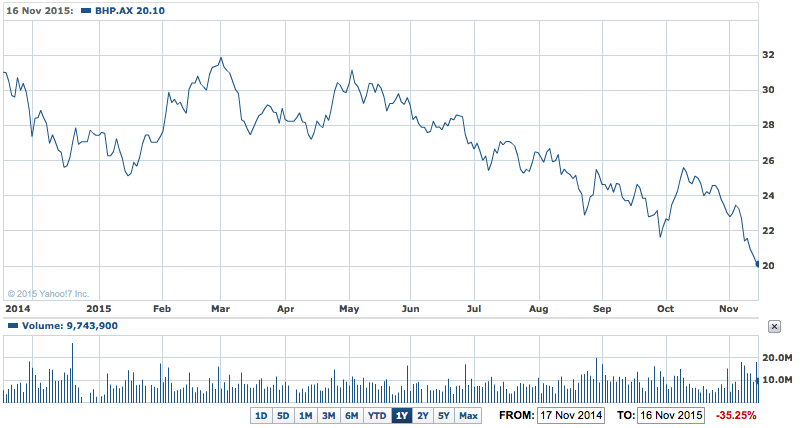A moment for some truth on Thursday in Perth when Australian shareholders meet at the 2014-15 annual meeting.
BHP Billiton (BHP) shares continued their recent sell-off yesterday by closing down 0.6% to close at $20.10 on the ASX, despite battling for much of the local trading session in the black. BHP shares also fell 0.6% in London overnight Monday.
The fall takes the drop since the Brazilian mine disaster earlier this month to more than 12%.
BHP 1Y – BHP to face questions from shareholders

The big question for shareholders will be BHP’s commitment to its dividend – which is very much under pressure.
What BHP said at the annual meeting for the London-based arm of BHP a month ago has been rendered irrelevant by the dam burst and loss of life at the Samarco mine in Brazil (jointly owned with Vale) and the further slide in commodity prices, especially oil, iron ore, coal, copper and gas.
Rather than talk the talk about corporate understanding and responsibility, BHP will have to put some hard cash on the table with or without Vale, and move onto the front foot on this terrible disaster.
The dam disaster is more than a question of dollars and cents and balance sheet strength (although both will help).
Cutting the dividend and diverting money that would have been paid to shareholders to meet the cost of cleaning up and rehabilitating the areas around the burst dams, will send a far stronger message than any ’talk’ and promises at the AGM.
BHP’s Australian-listed shares touched their lowest level last Friday ($19.81) since the financial crisis and close to 10-year lows in the aftermath of the dams disaster a week ago last Friday.
“I hope they cut the dividend,” one Australian-based fund manager, who holds shares in BHP, told AP Dow Jones. The unnamed manager expects the dividend to be a key topic at the meeting next week. "The [dividend] policy is creating havoc with the management of the company” who said
For Mr. Mackenzie, holding to BHP’s dividend is a reputational issue, but will that be larger than the blow to the company’s image from the dam disaster and loss of life.
BHP’s current policy is to maintain or lift investor payouts every half-year, even in the face of the downturn in world commodity markets in the last few years. That strong commitment is one of the key attractions of BHP to investors. But the question now, is it sound policy to maintain a progressive dividend and to be up for a billion dollars in costs, rehabilitation and other charges for its half share in fixing up the dam disaster?
BHP aims to generate enough cash flow each year not only to cover its costs, but also to fund new investment and its shareholder payout, without going too much further into debt. It can raise debt to pay for the Samarco costs (thereby generating a tax write-off from the interest costs to start with).
But a simpler message would be to maintain dividend for a year or so and tell the world that the fix-ups and other costs at Samarco come first. Goldman Sachs points out that the current dividend is too high for BHP’s profits and revenues outlook.
It says the company on average paid out around 20% of its earnings before interest, tax, depreciation and amortisation in the years from 1970 to 2012. To fall back to that level would take a 50% cut in current dividend.
So far, BHP has provided no explanation of what caused the Samarco disaster, and that has contributed to the rising level of criticism of the company in Brazil.
Some business writers say BHP appears to be running very careful and highly legal response in pointing out that it is a 50% shareholder in Samarco, which is a limited liability company. That might be clever, but it will backfire in Brazil and elsewhere.
The company’s shareholders will be looking for a clearer accounting on Thursday, and some leadership.
Overnight, BHP told analysts it was reviewing two other mining joint ventures, in Peru and Colombia, following the Samarco dam disaster.
BHP CEO Andrew McKenzie told analysts and investors that it was examining the structures of its Cerrejón coal joint venture in Colombia and its Antamina copper/zinc JV in Peru after the Brazil disaster.
Two dams collapsed on November 5 in southeast Brazil, killing nine people and spreading mud and mine waste over hundreds of kilometres.
The Brazilian mine is owned and operated by Samarco Mineração, a joint venture of BHP and Brazil’s Vale.
“We will look into, for our own benefit … the arrangements that we have at Samarco which mirror similar arrangements we have at Antamina and Cerrejón,” BHP chief executive Andrew Mackenzie told the conference call with analysts.
He did not give any idea of the outcome of the review.













